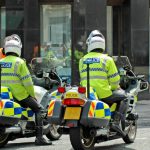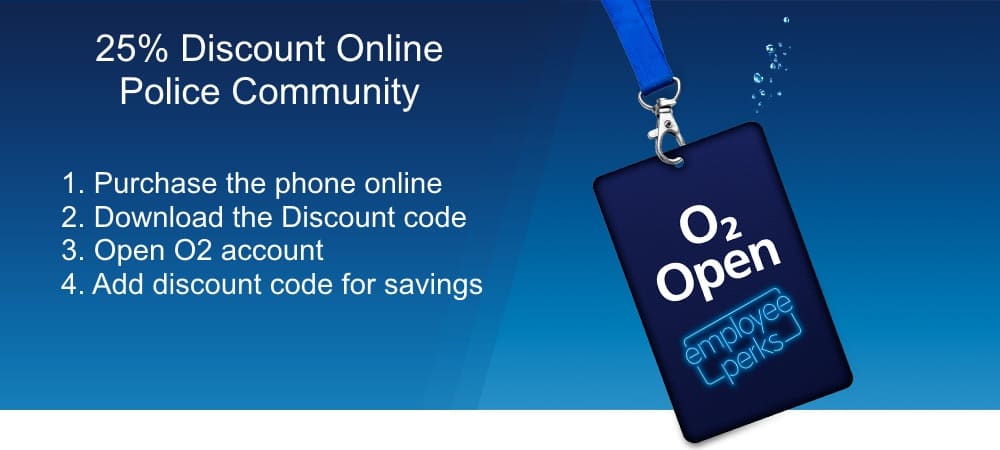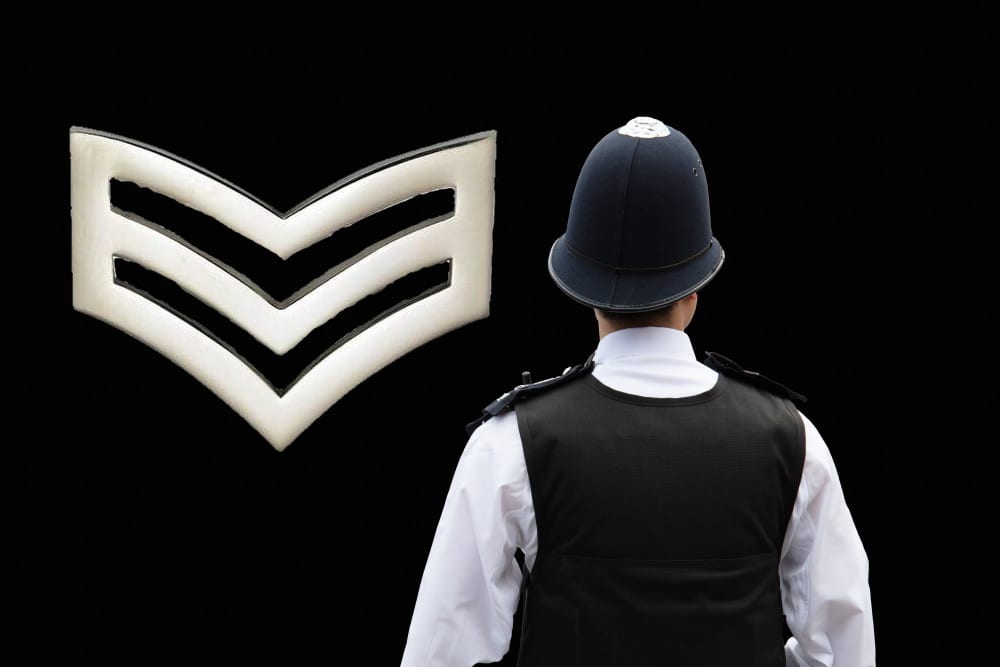
[ez-toc]
United Kingdom Police Ranks Explained
Whether you want to join the Police Service or learn more about the hierarchy of police officers in the UK, you should know that the United Kingdom uses a standardised set of police ranks. The only slight differences from the rest of the nation are the most senior ranks for the Metropolitan Police and City of London Police.
Officers wear their rank badges on the epaulette. Uniform design may also vary from one rank to another, although all uniforms are a dark blue or black colour.
In the United Kingdom, police officers are divided into several ranks, with constables at the bottom and Superintendents at the top. In between constables and chief inspectors are sergeants, inspectors and superintendents.
The specific rank of an officer depends on their years of service and training. constables make up the majority of police officers in the UK, and are responsible for patrolling their beats and responding to calls for service.
Sergeants provide supervision for constables and often act as shift commanders. Inspectors provide operational supervision for sergeants, while chief inspectors/superintendents provide strategic direction for officers at all levels.
Great Britain Police Ranks
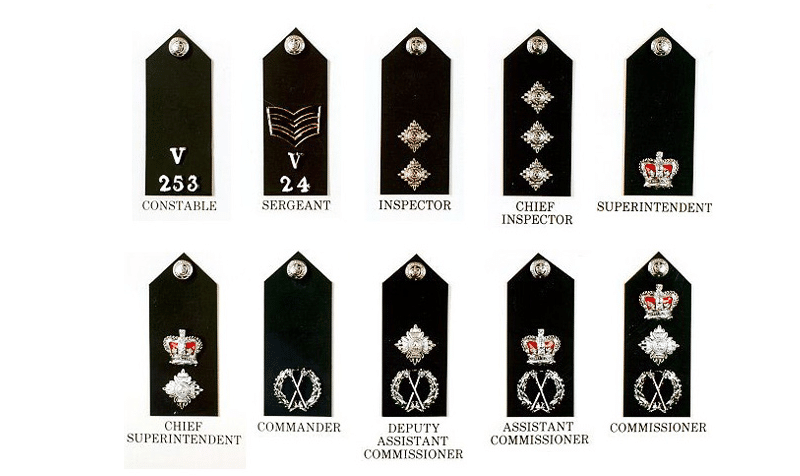
Constable
Constable is the first and lowest rank within the Police Forces. All new police officers are sworn in and hold the basic powers of a constable. As constables, all new police officers are required to undergo a probationary period of two years.
Upon successful completion, constables can decide whether they want to join one of the special units, apply for promotion to sergeant, or remain at their current rank.
Detective constables (DC) have the same basic powers as a constable, but this rank is assigned to officers who have passed the National Investigator’s Examination.
A constable epaulette shows an officer’s divisional code and an individual number that identifies the officer.
There is also another constable rank – The Special Constable. These officers are member of the public who join the police as volunteers and do NOT get paid. They undergo special constable police training on weekend and have to complete 36 hours a month unpaid work.
Sergeant
The first supervisory rank within the Police Forces. Most police sergeants have operational duties and are involved with day-to-day policing or prisoner handling, they can also perform custody sergeant roles. Detective sergeants hold the same power as their non-detective counterparts.
The epaulette feature three down-pointed sergeant chevrons surmounted by the officer’s identification number.
Inspector
Inspectors are superior to sergeants and the second supervisory rank within the police. The rank is mostly operational like sergeants, but uniformed inspectors must also supervise duty shifts or act in specialist roles.
The epaulettes don’t hold an identification number but are decorated with two Order of Bath stars placed one above the other.
Chief inspector
This is the minimum rank of a senior police officer. Chief inspectors can hold various functions within the Police Forces, such as commanding smaller units, replacing superintendents as the head police officers in some areas, or filling various staff posts.
Detective chief inspector is also the minimum senior rank of a senior investigating officer who can head major investigations, including murder. The epaulette doesn’t hold an identification number but features three Order of Bath stars.
Superintendent
The superintendent is a senior police officer rank superior to the chief inspector. However, the duties and responsibilities are similar. Superintendent epaulettes do not hold an identification number but feature a crown.
Chief superintendent
The chief superintendent plays a crucial role in operational policing and can also lead large or complex command areas within the Forces. Often acting as part of the Chief Officer Team, chief superintendents are also involved in planning and directing activities, ensuring public safety, and strengthening public confidence.
The chief superintendent epaulette features one Order of Bath star with a crown on top of it.
Assistant chief constable
The assistant chief constable is the third-highest rank in the British police forces, except for the Metropolitan Police and the City of London Police.
Officers in this rank hold lead positions within the Forces and are usually given responsibilities for policing major territories within an area. The rank is shown on the epaulette by crossed tipstave within a wreath.
Deputy chief constable
The second in command, a deputy chief constable takes responsibilities for territorial policing or fulfils corporate roles, depending on the forces. Since 2006, each force has been permitted to have more than one deputy chief constable – although most smaller forces only have one.
The rank badge worn by a deputy chief constable features one Order of Bath star on top of a crossed tipstave within a wreath.
Chief constable
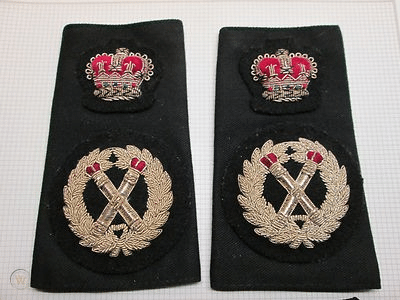
The highest rank within the Police Forces, the chief constable is responsible for territorial policing in large areas.
Chief constables have no superior and are generally appointed by a Police and Crime Commissioner or an elected mayor. The same authorities can dismiss the chief constable if necessary.
The badge of rank on the epaulette features a crossed tipstave within a wreath surmounted by a crown.
Metropolitan Police Ranks
The Metropolitan Police is the territorial police force responsible for law enforcement and the prevention of crime in Greater London.
Within the Metropolitan Police, the lower ranks are the same as the national ranks, but the sergeant epaulette features the divisional code and officer’s identification number under the three down-pointed chevrons.
The ranks and epaulettes remain invariable for all other ranks up to Chief Superintendent. However, the Met doesn’t have assistant chief constables, deputy chief constables, or chief constables. Instead, the senior roles are:
- Commander: Badge rank features a crossed tipstave within a wreath.
- Deputy assistant commissioner: Badge rank features a crossed tipstave within a wreath surmounted by one Order of Bath star.
- Assistant commissioner: Badge rank features a crossed tipstave within a wreath surmounted by a crown with blue fabric instead of red.
- Deputy commissioner: Badge rank features a crossed tipstave within a wreath surmounted by two Order of Bath stars placed one next to the other, surmounted by a crown with blue fabric instead of red.
- Commissioner: Badge rank features a crossed tipstave within a wreath surmounted by one Order of Bath star surmounted by a crown with blue fabric instead of red.
City of London Police Ranks
The City of London Police is responsible for law enforcement and the prevention of crime within the City of London.
The police ranks from constable to chief superintendent are the same as the other national forces, but the insignia on the epaulettes is gold instead of silver. All officers of these ranks also have the personal identification number placed on top or below the rank badge.
Superior ranks include:
- Commander: Badge rank features a golden crossed tipstave within a wreath.
- Assistant commissioner: Badge rank features a golden crossed tipstave within a wreath surmounted by a golden Order of Bath star.
- Commissioner: Badge rank features a golden crossed tipstave within a wreath surmounted by a golden Order of Bath star, surmounted by a golden crown with red fabric.
Superior order rank badges don’t include the officer’s personal identification number on the epaulette.
DETECTIVE POLICE RANKS
Detective ranks are no higher than other police ranks. The detective ranks run alongside their uniform colleagues, the pay scales are the same and there is no alternate rank slide or badge.
Example – Constable who gains a detective role then becomes a detective constable. The same as a Sergeant who moves into or pass the detective exam, then becomes a detective Sergeant.
CONCULSION
The different police ranks in the United Kingdom are important to maintain order and peace. Each rank has specific duties that they must carry out in order to help keep their communities safe. While some people may think that a certain rank is more important than another, it’s clear that each one plays an essential role in keeping society functioning. What do you think is the most important rank in the UK police force?
Identifying a police officer’s rank is important, whether you want to become an officer yourself or use the officer’s formal title.
We hope this guide can help you understand the badge differences between the various police ranks?







